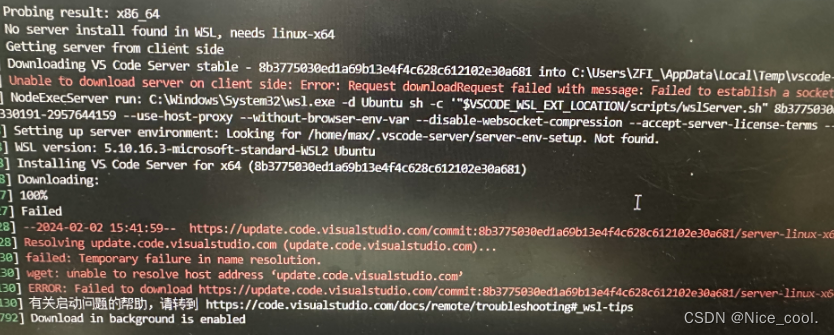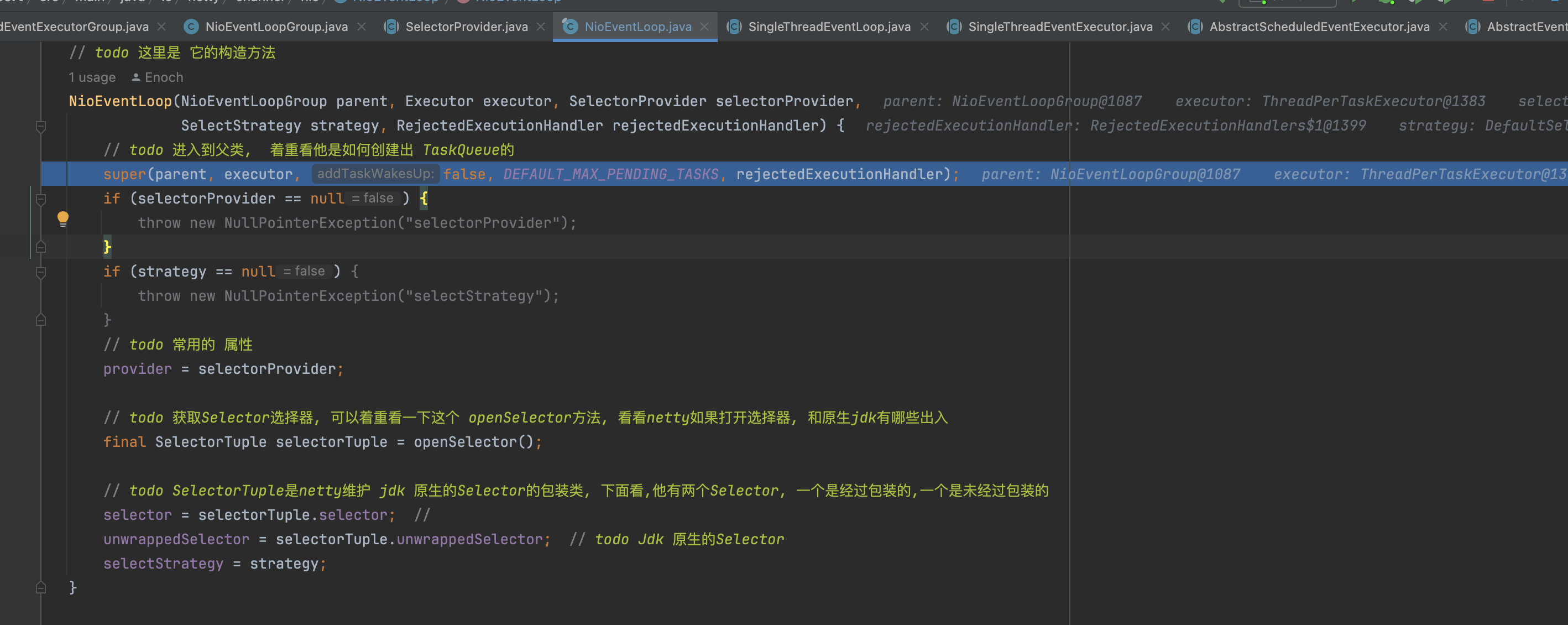一、 What are servlets?

1. 定义
(1)Servlets are Java’s answer to CGI:
| programs that run on a web server acting as middle layer between HTTP request and databases or other applications. |
| Used for client requests that cannot be satisfied using pre-built (static) documents. |
| Used to generate dynamic web pages in response to client. |
(2)图解
| Web Browser | Sending Requests to a Web Server |
| Web Server | |
| Server Side Programs | |
| Dynamic response | – database lookup, calculation etc. |
| We’ll look at the Java solution | how to write servlets; how the container (Tomcat) works. |
2. A general purpose Web Server
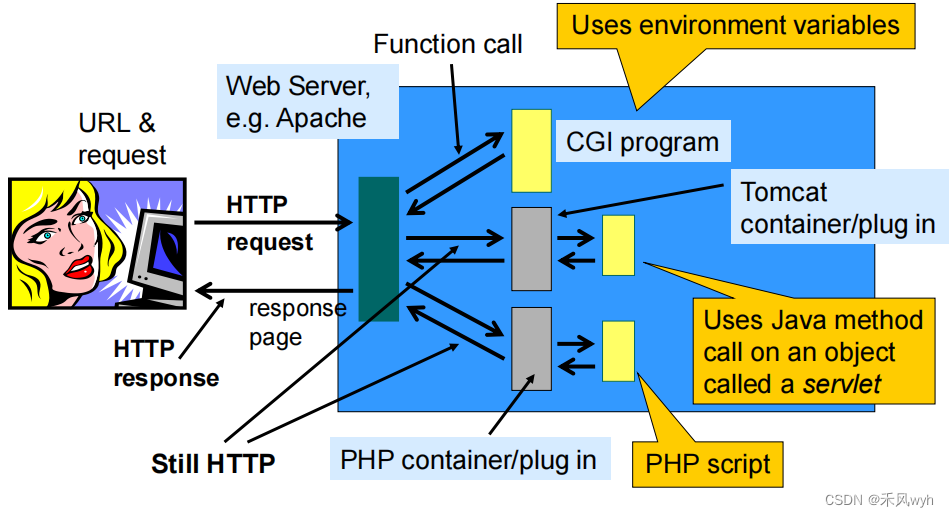
二、Simple Example
<form action=“http://server.com/ExecuteServlet”>
<input type=“submit” value = “press for servlet”>
</form>1. A Basic Servlet
import jakarta.servlet.*;
import jakarta.servlet.http.*;
import java.io.*;
//import jakarta.servlet.*:imports classes in this directory, but not in sub-directories
public class HelloServlet extends HttpServlet {
public void doGet(HttpServletRequest request,HttpServletResponse response) throws IOException, ServletException {
response.setContentType("text/html");//设置响应文件类型、响应式的编码形式
PrintWriter out = response.getWriter();//获取字符输出流
out.println(“<html><body>Hello!</body></html>”);
out.close();
}
}2. Echo Servlet
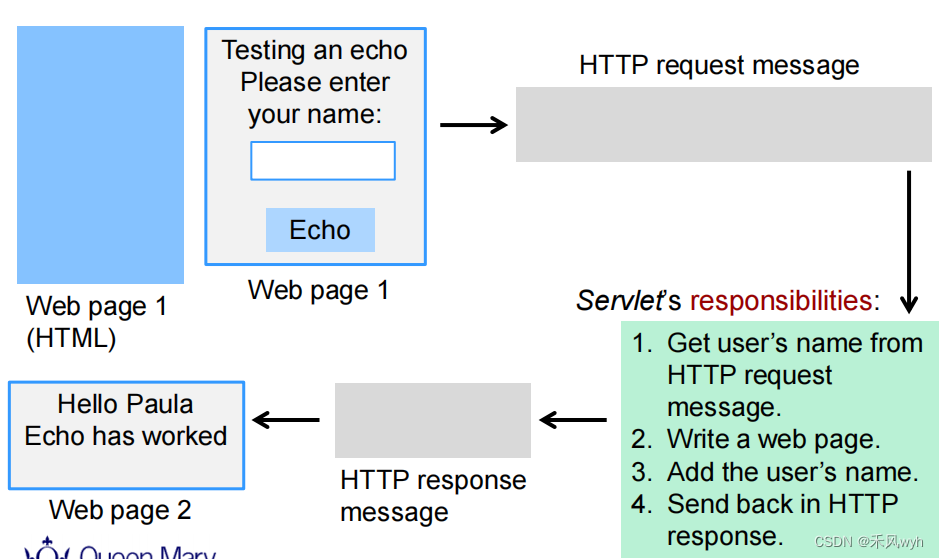
import jakarta.servlet.*;
import jakarta.servlet.http.*;
import java.io.*;
public class GetEchoServlet extends HttpServlet {
public void doGet(HttpServletRequest request,HttpServletResponse response)throws IOException, ServletException {
String userName = request.getParameter(“fname”);//获取form中输入的参数
response.setContentType("text/html");//设置响应文件类型、响应式编码格式
PrintWriter out = response.getWriter();//获取字符输出流
out.println(“<html><body>Hello”);
if (userName != null)
out.println(userName);
else
out.println(“mystery person”);
out.println(“</body></html>”);
out.close();
}
}3. BMI Servlet
– HTML
//Page that asks for weight (kg) and height (cm) :Write the HTML and the HTTP Request (GET)
<form method=“GET”action=“http://server.com/BMIServlet”>
<input type=“text” name=“weight”/>weight<br>
<input type=“text” name=“height”/>height<br>
<input type=“submit” value=“send”>
</form>– Servlet
import jakarta.servlet.*;
import jakarta.servlet.http.*;
import java.io.*;
public class BMIServlet extends HttpServlet {
public void doGet(HttpServletRequest request,HttpServletResponse response) throws IOException,ServletException {
String ht = request.getParameter(“height”);
int height = Integer.parseInt(ht);
double weight = Double.parseDouble(request.getParameter(“weight”));
double ht_squared = (height/100.0)*(height/100.0);
response.setContentType("text/html");
PrintWriter out = response.getWriter();
out.println(“<html><body><br>”);
out.println(“Your BMI is: ” + weight/ht_squared + “<body></html>”);
out.close();
}
}4. Name-salary Servlet
import jakarta.servlet.*;
import jakarta.servlet.http.*;
import java.io.*;
public class HelloServlet extends HttpServlet {
public void doPost(HttpServletRequest request,HttpServletResponse response) throws IOException, ServletException {
String name = request.getParameter("name");
int salary = Integer.parseInt(salary);
response.setContentType("text/html");
PrintWriter out = response.getWriter();
out.println("<html><body><br>");
out.println("Hello,"+name);
out.println("Your salary is"+salary);
out.println("<body><html>");
out.close();
} // end of method
} // end of class三、Servlet Key Points
1. Servlets: Key points
| NO main method | public static void main(String[] args) |
| NO constructor |
There is one (default) constructor but the developer should never write an explicit constructor – Why——servlet lifecycle |
| Two key (service) methods | doGet(); doPost() |
2. Finding things
| Tracing the user data |
– name in HTTP request message
– argument in request.getParameter(…)
|
| String(int/double required) |
then have to use appropriate method on this String to convert – Integer.parseInt(); – Double.parseDouble(); |
| Finding the servlet |
3. JavaBeans, JSPs and Servlets
| Although a servlet can be a completely self-contained program, to ease server-side programming, generating content should be split into | |
| The presentation logic (content presentation, or graphic design rules), which determines how information is presented to the user. | |
| controller | the servlet handles the HTTP protocol and coordination of which other servlets and auxiliary class methods to call |
| model | Java classes/JavaBeans handle the business logic |
| view | Java Server Pages handle presentation logic |
4. Advantages of Servlets over CGI
| Efficient | |
| Convenient | – Provides infrastructure that parses and decodes HTML forms. |
| Powerful | |
| Portable | – Written in Java and follows standard API. |
| Secure |
– Array checking & exception handling is automatic in Java.
|
| Inexpensive |
四、Servlets in Detail
1. A general purpose Web Server
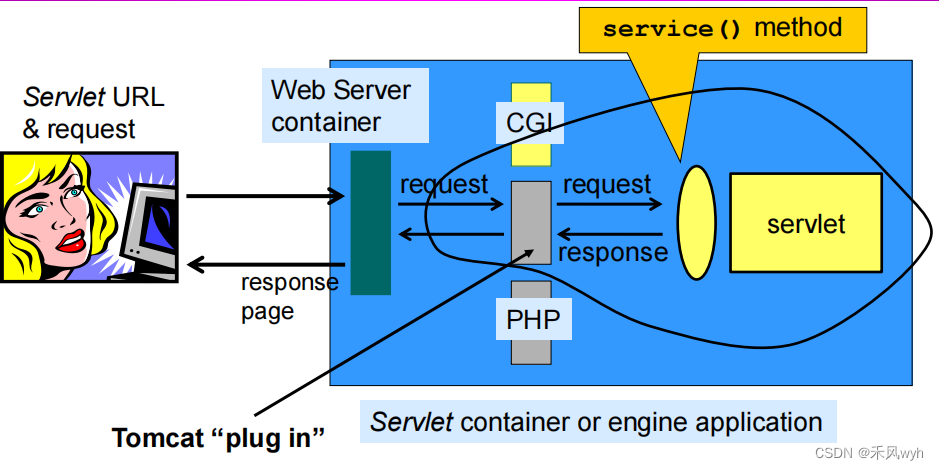
2. What servlets do
| request | Read any data sent by the user |
| Look up information embedded in HTTP request | |
|
Generate results.
|
|
| response |
Format results inside a document (e.g. HTML, XML, GIF, EXCEL).
|
3. Typical generic servlet code
import java.io.*;
import jakarta.servlet.*;
public class AnyServlet extends GenericServlet {
public AnyServlet() {}
// constructor – BUT USE THE DEFAULT
// NEVER ANY NEED TO WRITE ONE
//ONLY creates an object, becomes a “proper” servlet after init().
public void init(ServletConfig config) throws ServletException;
// The method is actually called by container when servlet is
// first created or loaded.
public void service(ServletRequest req, ServletResponse res)throws ServletException, IOException;
// Called by a new thread (in the container) each time a
// request is received.
public void destroy();
// Called when servlet is destroyed or removed.
}4. A Servlet is “deployed” in a container
– creates & passes request and response objects to chosen servlet;
– passes the response (e.g. HTTP response) back to the web server application; kills servlet thread or recycles into thread pool; and deletes request and response objects.
• More generally, manages the life cycle of its servlets:
– Calls constructor, init(), service(), destroy().
• It has a main() and is working “all the time”.
• Also provides:
– JSP support.
5. Dissecting the Container’s actions
– HTTP request:
GET /myServlet/BMIInfo height=156&name=paula+fonseca HTTP/1.1
– Servlet:
public class BMIServlet extends HttpServlet {public void doGet(HttpServletRequest request, HttpServletResponse response) throwsIOException, ServletException {// …String ht = request.getParameter(“height”);// …}}
6. The servlet life cycle
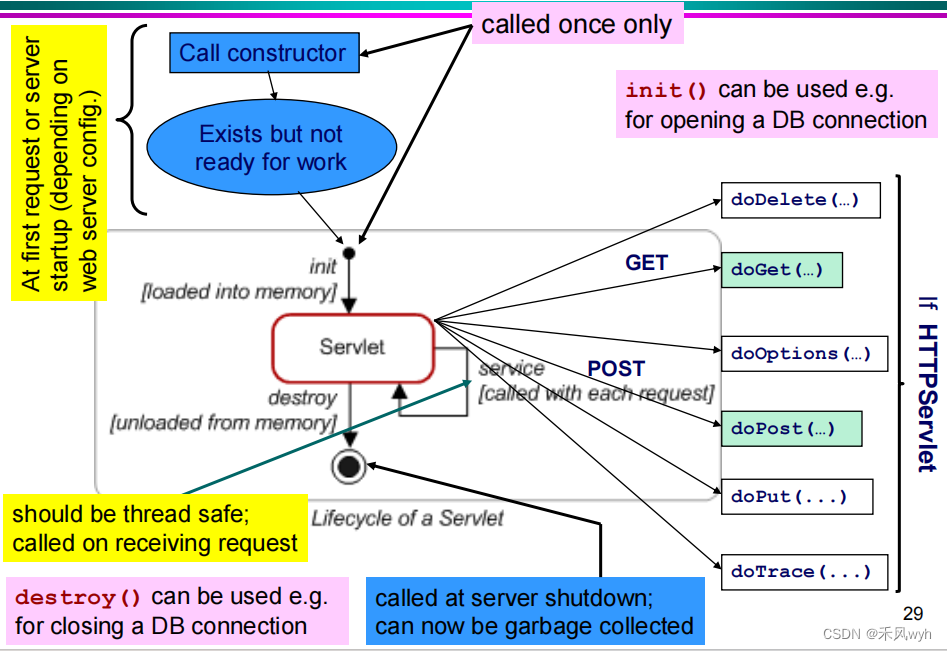
7. methods & inheritance
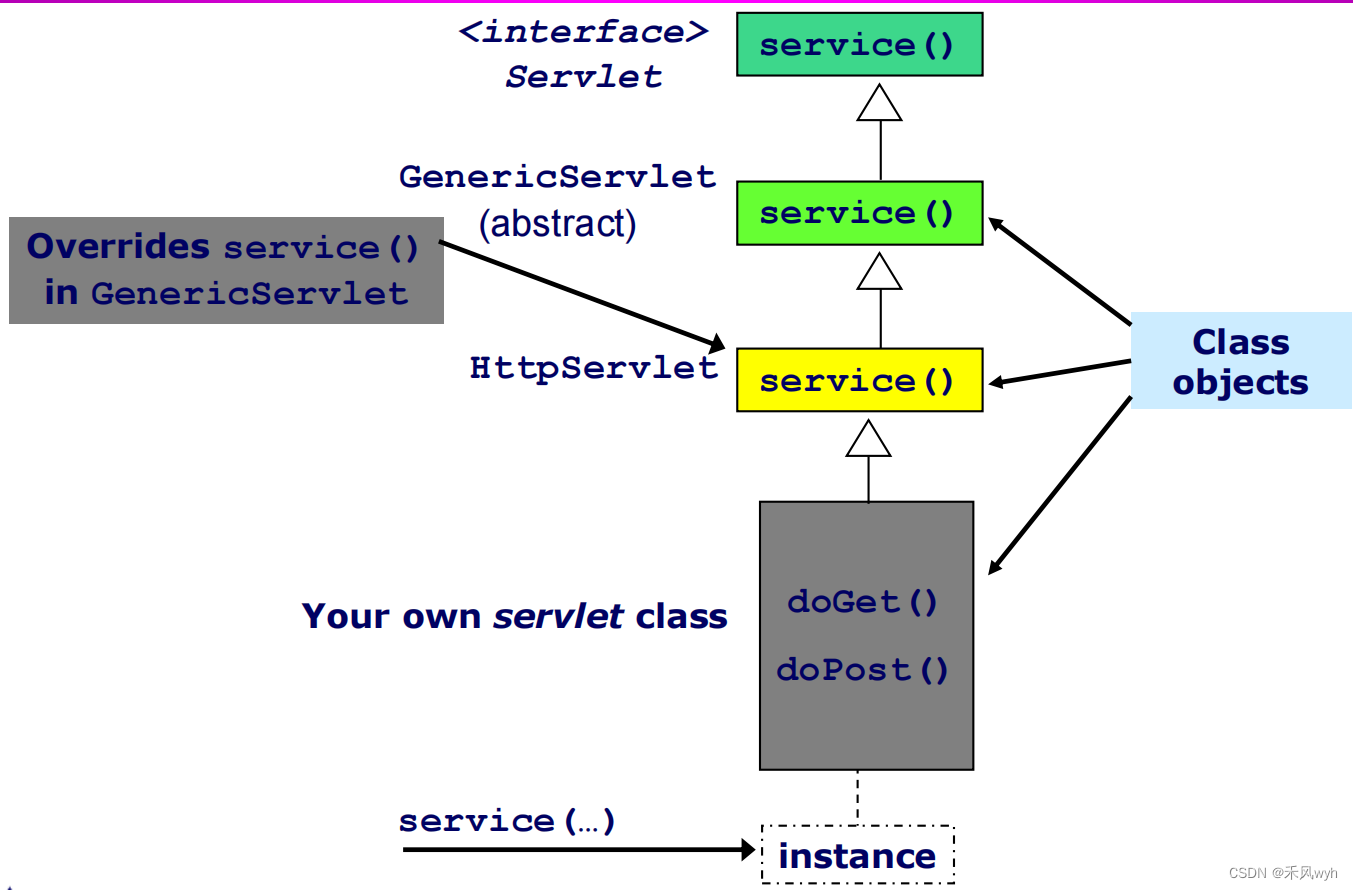
8. Servlet’s Life cycle
| Constructor (no arguments) |
– not written or called by a developer
– called by the container
|
| public void init() |
– called after constructor
– called once, at the beginning (so potentially useful for initialisation of, e.g. databases)
– can be overridden by the developer
|
| public void service(…) |
– rarely overridden by thedeveloper
– called everytime
|
|
public void doGet() / public void doPost() |
– must be written by the developer
– must match the HTTP method in <form> in the HTML
|
| public void destroy() |
– must be written by the developer |
五、 Configuration Servlets To Run In Tomcat
1. Mapping names using the Deployment Descriptor (DD)
//For each servlet in the web application.
//Internal name of servlet can be “anything” following XML rules.
<web-app ...>
<servlet>
<servlet-name>…</servlet-name>
//maps internal name to fully qualified class name (except without .class)
<servlet-class>…</servlet-class>
//maps internal name to public URL name e.g. /makebooking
</servlet>
<servlet-mapping>
<servlet-name>…</servlet-name>
<url-pattern>…</url-pattern >
</servlet-mapping>
...
</web-app>2. Servlet Mapping Examples
– HTML:<FORM method=“post” action=“/servlet/MyTest.do”>– Server (webapps):WEB-INF/classes/Echo.class<servlet><servlet-name>……</servlet-name><servlet-class>…..</servlet-class></servlet><servlet-mapping><servlet-name>……</servlet-name></servlet-mapping>– HTML:<FORM method=“post” action=“/servlet/Test”>– Server (webapps):WEB-INF/classes/foo/Name.class<servlet><servlet-name>……</servlet-name><servlet-class>…..</servlet-class></servlet><servlet-mapping><servlet-name>……</servlet-name><url-pattern>…….</url-pattern ></servlet-mapping>
3. Example: A Small Form
//SmallForm.html
<html>
<title>Sending Form Information to a Servlet</title>
<body>
<form action="http://localhost:8080/servlet/elem004.ProcessSmallForm"method="post">
//Can use absolute or relative URLs or pre-configured names.
Please input your login: <br>
<input type="text" name="Login">
<input type="submit" value="Login">
</form>
</body>
</html>
//the Deployment Descriptor (web.xml) and the servlet
<servlet>
<servlet-name>smallForm</servlet-name>
<servlet-class>SmallFormServlet</servlet-class>
</servlet>
<servlet-mapping>
<servlet-name>smallForm</servlet-name>
<url-pattern>/servlet/elem004.ProcessSmallForm</url-pattern>
</servlet-mapping>4. Putting everything in the right place
| Level 1 | WEB-INF (folder) and .html, .jsp |
| Level 2 | (inside WEB-INF folder): web.xml and classes (folder) |
| Level 3 | (inside classes folder): servlet .class files (and other “business” class files e.g. JavaBeans) |
5. Servlet initialisation & Servlet Configuration object
• Only one servlet instance is created: each request is serviced by a separate thread in the container.
• Prior to initialisation, the ServletConfig object is created by the container:
– one ServletConfig object per servlet;
– container uses it to pass deploy-time information to the servlet (data you do not want to hard code into the servlet, e.g. the DB name);
– the names are specified in the DD.
• Parameters are set in a server-specific manner, e.g.
– in a file called web.xml (for Tomcat);
– in a file called resin.config (for Resin).
• Parameters do not change while servlet is deployed and running:
– like constants;
– if servlet changes, then need to redeploy.
6. Example: DD’s init parameters (web.xml for Tomcat)
<web-app xmlns=“http://java.sun.com/xml/ns/j2ee”
xmlns:xsi=“http://www.w3.org/2001/XMLSchema-instance”
xsi:schemaLocation=“http//java.sun.com/xml/ns/j2ee/web-app_2.4.xsd”
version=“2.4”>
<servlet>
<servlet-name>Hello World Servlet</servlet-name>
<servlet-class>S1</servlet-class>
<init-param>
<param-name>lecturersEmail</param-name>
<param-value>paula.fonseca@qmul.ac.uk</param-value>
</init-param>
//Container reads these & gives them to ServletConfig object.
</servlet>
</web-app>out.println(getServletConfig().getInitParameter(“lecturersEmail”));Returns the servlet’s ServletConfig object (all servlets have this method).Getting a parameter value from the ServletConfig object; this code is in servlet.
7. Creating a servlet: ServletConfig and init(…)
| Step 1 | container reads the deployment descriptor |
| Step 2 | container creates new ServletConfig object |
| Step 3 |
container creates name/value pair (Strings) for each
servlet init-param |
|
Step 4
|
|
| Step 5 | container creates new instance of the servlet class |
| Step 6 |
container calls servlet’s init() method passing in reference to the ServletConfig object
|
六、Thread Safety And Putting Things Together
1. Instance Variables
public class ExampletServlet extends HttpServlet {
private int age;
public void init() { age = 0; }
public void doGet(HttpServletRequest request,
HttpServletResponse response) throws
IOException, ServletException {
age = Integer.parseInt(request.getParameter(“age”));
response.setContentType(“text/html”);
PrintWriter out = response.getWriter();
out.println(“<HTML><BODY>You are ” + age + “ weeks old”);
out.println(“</BODY></HTML>”);
out.close();
}
}2. The 3 Threads access same Resources
• We don’t know whose age will be displayed!
• Solution 1:
– Never use instance variables in servlets (some books say you
can’t – what they mean is you shouldn’t!).
– Find a way to save information (state) about each user (i.e.
each request) – we’ll see how later …
• Solution 2:
– Synchronisation – a lock that makes a variable thread-safe
3. Access – introducing the ServletContext object
• Servlet
– ServletConfig object – one per servlet (or JSP)
– contains init params
– all requests made to a servlet can access this object
• Web application
– ServletContext object – one per web application
• Web applications normally have several servlets/JSPs.
– Used to access web application parameters that need to be seen by all servlets/JSPs in the application.
• A misnomer, as it relates not to a servlet but to the set of
servlets and JSPs in the web application.
servlets and JSPs in the web application.
The web application’s DD specifies the context parameters
<web-app ...> ...
<servlet>
<servlet-name>...</servlet-name>
<servlet-class>...</servlet-class>
<init-param>
<param-name>...</param-name>
<param-value>...</param-value></init-param>
</servlet> ... + other servlets
<context-param>
<param-name>HOP_Email</param-name>
<param-value>g.tyson@qmul.ac.uk</param-value>
</context-param>
...
</web-app>Note: Not inside any servlet. These are parameter namevalue pairs: both are strings.
ServletContext object created and set up when web application is deployed.
4. To access web app parameters in servlet code
ServletContext ctx = getServletContext();
out.println(ctx.getInitParameter(“HOP_Email”));
– Typical use (of former) is a DB lookup name.
• Can access ServletContext,
– directly:
getServletContext().getInitParameter(…)
getServletContext().getInitParameter(…)
– from ServletConfig:
getServletConfig().getServletContext().getInitParameter(…)
getServletConfig().getServletContext().getInitParameter(…)
– Latter is useful if in a method of an auxiliary class e.g. a JavaBean, and only the ServletConfig object has been passed as a parameter.
Same name for get method as when accessing ServletConfig object.
5. ServletContext also has attributes
• Attributes are name-value pairs where the name is a String, but
the value is an object (that may not be a String).
the value is an object (that may not be a String).
– accessed by getAttribute(String);
– set by setAttribute(String,Object).
• Running code prior to invoking any servlet in the application:
– E.g. to turn sets of parameters into attribute objects,
• so all servlets only need to deal with objects;
• and don’t have to read the context parameters.
– Implement a ServletContextListener (out of scope here)
6. Servlets – The Basics: Key Points & What we can’t do yet
| How to call a servlet in an HTML form | What a deployment descriptor does |
| How to write a servlet | Where to deploy files |
| How to access client information | Servlet life-cycle |
| Initialisation |
– ServletConfig
– ServletContext
|
| Have a conversation with a client |
– Shopping basket
– Session object
|
| Run any code before a servlet starts |
– E.g. Database set up
– Listeners
|
|
Send client information, or control, to another servlet/JSP |
– Could be in another web server
– Redirect and forward
|
7. Extracting unknown parameters and multiple values
| String getParameter(String) |
parameter name is known:
– returns null if unknown parameter;
– returns “” (i.e. empty string) if parameter has no value.
|
| Enumeration getParameterNames() | obtain parameter names |
| String[] getParameterValues(String) |
obtain an array of values for each one:
– returns null if unknown parameter;
– returns a single string (“”) if parameter has no values. Case sensitive.
|
8. Example: A Big Form
//BigForm.html
<form action="http://localhost:8080/servlet/elem004.ProcessBigForm"method="post">
Please enter: <br><br>
Your login: <input type="text" name="Login"> <br><br>
Your favourite colour:
<input type="radio" name="Colour" value="blue">Blue
<input type="radio" name="Colour" value="red">Red
<input type="radio" name="Colour" value="green">Green <br><br>
//Single-value parameters.
Which of these courses you are taking: <br>
<input type="checkbox" name="Course" value="elem001">ELEM001 <br>
<input type="checkbox" name="Course" value="elem002">ELEM002 <br>
<input type="checkbox" name="Course" value="elem003">ELEM003 <br>
<input type="checkbox" name="Course" value="elem004">ELEM004 <br>
<input type="submit" value="Send to Servlet">
//Multiple-value parameter.
</form>
//After BigForm is processed.getParameterNames() returns parameters in no particular order.
//ProcessBigForm.java
//More code here ...
out.println("<table border=1>");
// Obtain all the form’s parameters from the request object.
Enumeration paramNames = req.getParameterNames();
while (paramNames.hasMoreElements()) {
String paramName = (String) paramNames.nextElement();
// Obtain values for this parameter and check how many there are.
String[] paramValues = req.getParameterValues(paramName);
if (paramValues.length == 1) { // a single value
String paramVal = req.getParameter(paramName);
out.println("<tr><td>" + paramName +"</td><td>"+ paramVal + "</td></tr>");
}else { // If several values print a list in the table.
out.println("<tr><td>" + paramName +"</td><td><ul>");
for (int i = 0; i < paramValues.length; i++)
out.println("<li>" + paramValues[i] + "</li>");
out.println("</ul></td></tr>");
}
}
out.println("</table>");
out.close();
}
原文地址:https://blog.csdn.net/weixin_62403234/article/details/134458163
本文来自互联网用户投稿,该文观点仅代表作者本人,不代表本站立场。本站仅提供信息存储空间服务,不拥有所有权,不承担相关法律责任。
如若转载,请注明出处:http://www.7code.cn/show_1869.html
如若内容造成侵权/违法违规/事实不符,请联系代码007邮箱:suwngjj01@126.com进行投诉反馈,一经查实,立即删除!
主题授权提示:请在后台主题设置-主题授权-激活主题的正版授权,授权购买:RiTheme官网
声明:本站所有文章,如无特殊说明或标注,均为本站原创发布。任何个人或组织,在未征得本站同意时,禁止复制、盗用、采集、发布本站内容到任何网站、书籍等各类媒体平台。如若本站内容侵犯了原著者的合法权益,可联系我们进行处理。


